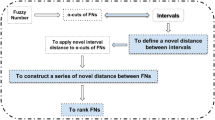Abstract
In this paper, we propose some distance measures between type-2 fuzzy sets, and also a new family of utmost distance measures are presented. Several properties of different proposed distance measures have been introduced. Also, we have introduced a new ranking method for the ordering of type-2 fuzzy sets based on the proposed distance measure. The proposed ranking method satisfies the reasonable properties for the ordering of fuzzy quantities. Some properties such as robustness, order relation have been presented. Limitations of existing ranking methods have been studied. Further for practical use, a new method for selecting the best alternative, for group decision making problems is proposed. This method is illustrated with a numerical example.
Similar content being viewed by others
References
Zadeh L A. The concept of a linguistic variable and its application to approximate reasoning—i. Information Sciences, 1975, 8(3): 199–249
Dubois D J. Fuzzy sets and systems: theory and applications. volume 144. Academic press, 1980
Karnik N, Mendel J. Operations on type-2 fuzzy sets. Fuzzy Sets and Systems, 2001, 122(2): 327–348
Mizumoto M, Tanaka K. Some properties of fuzzy sets of type 2. Information and Control, 1976, 31(4): 312–340
Liang Q, Mendel J M. Interval type-2 fuzzy logic systems: theory and design. IEEE Transactions on Fuzzy Systems, 2000, 8(5): 535–550
Mendel J M, John R B. Type-2 fuzzy sets made simple. IEEE Transactions on Fuzzy Systems, 2002, 10(2): 117–127
Yager R R. Fuzzy subsets of type ii in decisions. Cybernetics and System, 1980, 10(1–3): 137–159
Hisdal E. The if then else statement and interval-valued fuzzy sets of higher type. International Journal of Man-Machine Studies, 1981, 15(4): 385–455
Mendel J M, Wu H. New results about the centroid of an interval type-2 fuzzy set, including the centroid of a fuzzy granule. Information Sciences, 2007, 177(2): 360–377
Wu D, Mendel J M. A comparative study of ranking methods, similarity measures and uncertainty measures for interval type-2 fuzzy sets. Information Sciences, 2009, 179(8): 1169–1192
Türksen I B. Interval valued fuzzy sets based on normal forms. Fuzzy Sets and Systems, 1986, 20(2): 191–210
Türkşen I B. Type 2 representation and reasoning for cww. Fuzzy Sets and Systems, 2002, 127(1): 17–36
John R. Type 2 fuzzy sets: an appraisal of theory and applications. International Journal of Uncertainty, Fuzziness and Knowledge-Based Systems, 1998, 6(6): 563–576
John R, Czarnecki C. A type 2 adaptive fuzzy inferencing system. In: 1998 IEEE International Conference on Systems, Man, and Cybernetics. 1998, 2068–2073
Mitchell H. Ranking type-2 fuzzy numbers. IEEE Transactions on Fuzzy Systems, 2006, 14(2): 287–294
Hung W L, Yang M S. Similarity measures between type-2 fuzzy sets. International Journal of Uncertainty, Fuzziness and Knowledge-Based Systems, 2004, 12(06): 827–841
Mitchell H. Correlation coefficient for type-2 fuzzy sets. International Journal of Intelligent Systems, 2006, 21(2): 143–153
Yang M S, Lin D C. On similarity and inclusion measures between type-2 fuzzy sets with an application to clustering. Computers & Mathematics with Applications, 2009, 57(6): 896–907
Yang M S, Shih H M. Cluster analysis based on fuzzy relations. Fuzzy Sets and Systems, 2001, 120(2): 197–212
Hwang C M, Yang M S, Hung W L, Stanley Lee E. Similarity, inclusion and entropy measures between type-2 fuzzy sets based on the sugeno integral. Mathematical and Computer Modelling, 2011, 53(9): 1788–1797
Kacprzyk J. Multistage fuzzy control: a prescriptive approach. John Wiley & Sons, Inc., 1997
Ivanescu A M, Wichterich M, Beecks C, Seidl T. The classi coefficient for the evaluation of ranking quality in the presence of class similarities. Frontiers of Computer Science, 2012, 6(5): 568–580
Jia L, Xi J, Li M, Liu Y, Miao D. Eti: an efficient index for set similarity queries. Frontiers of Computer Science, 2012, 6(6): 700–712
Li X, Mao W, Zeng D. Forecasting complex group behavior via multiple plan recognition. Frontiers of Computer Science, 2012, 6(1): 102–110
Qin Z, Wan T. Hybrid bayesian estimation tree learning with discrete and fuzzy labels. Frontiers of Computer Science, 2013, 7(6): 852–863
Jin C, Zhang J, Zhou A. Continuous ranking on uncertain streams. Frontiers of Computer Science, 2012, 6(6): 686–699
Kumar A, Singh P, Kaur P, Kaur A. A new approach for ranking of LR type generalized fuzzy numbers. Expert Systems with Applications, 2011, 38(9): 10906–10910
Kumar A, Singh P, Kaur P, Kaur A. Rm approach for ranking of L-R type generalized fuzzy numbers. Soft Computing, 2011, 15(7): 1373–1381
Singh P. A new approach for the ranking of fuzzy sets with different heights. Journal of Applied Research and Technology, 2012, 10(6): 941–949
Singh P. A new similarity measure between interval-valued intuitionistic fuzzy sets. Journal of Intelligent and Fuzzy Systems, 2013
Verma M, Kumar A, Singh P, Singh Y. Risk analysis of combustion system using vague ranking method. Journal of Intelligent and Fuzzy Systems, 2013, 24(4): 765–773
Verma M, Kumar A, Singh Y, Allahviranloo T. Application of nonnormal p-norm trapezoidal fuzzy number in reliability evaluation of electrical substations. Neural Computing and Applications, 2013, 23(2): 531–539
Wang X, Kerre E E. Reasonable properties for the ordering of fuzzy quantities (i). Fuzzy Sets and Systems, 2001, 118(3): 375–385
Chen S M, Yang M W, Lee L W, Yang S W. Fuzzy multiple attributes group decision-making based on ranking interval type-2 fuzzy sets. Expert Systems with Applications, 2012, 39(5): 5295–5308
Author information
Authors and Affiliations
Corresponding author
Additional information
Pushpinder Singh received the Ph.D. degree in the School of Mathematics and Computer Applications from Thapar University Patiala, India. He is currently working as post doctoral fellow with the Department of Computer Science at Palacky University, Olomouc, Czech Republic. His research interests include fuzzy similarity measures, group decision making problems etc.
Rights and permissions
About this article
Cite this article
Singh, P. Some new distance measures for type-2 fuzzy sets and distance measure based ranking for group decision making problems. Front. Comput. Sci. 8, 741–752 (2014). https://doi.org/10.1007/s11704-014-3323-3
Received:
Accepted:
Published:
Issue Date:
DOI: https://doi.org/10.1007/s11704-014-3323-3




